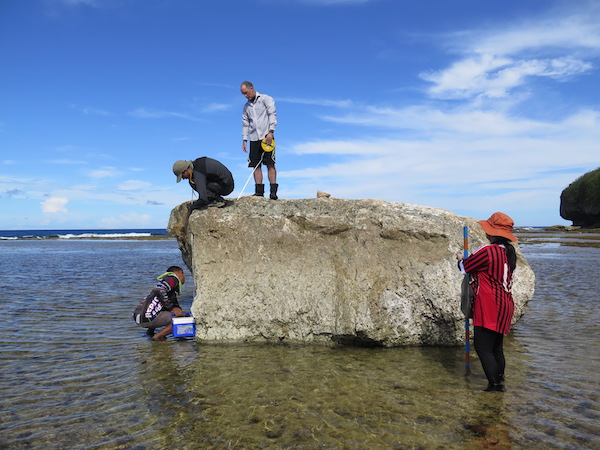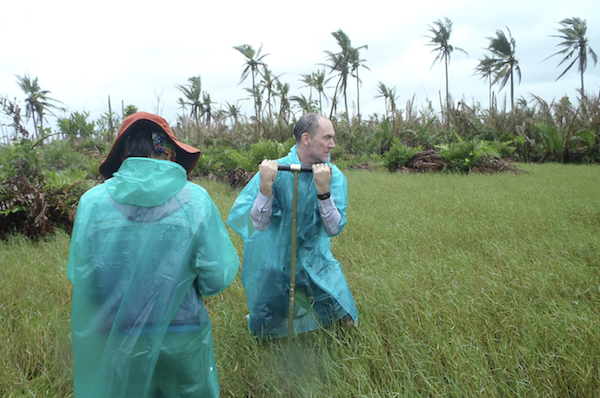Sedimentation expert Adam Switzer says his years as a professional surfer has shaped much of his research and work.

As a child, Associate Professor Adam Switzer was always on the lookout for the next big wave. At the age of 17, he became a professional surfer.
Juggling between his books and his surfboard, the Australian spent a large part of his next nine years being tossed about by crests and swells, before calling it quits because of a bad shoulder injury.
With the heady days of riding waves behind him, Assoc Prof Switzer decided to study them instead, focusing his research on tsunamis and storms.
“The physical cumulative stress of surfing was something that pushed me to go and get a ‘real’ job,” said Assoc Prof Switzer. “My surfing career did kind of morph into my academic career. It still helps, even to this day.”

He is now a Principal Investigator at the Earth Observatory of Singapore (EOS), an institution that conducts research on earthquakes, volcanoes, tsunamis and climate change in and around Southeast Asia. He also teaches at the Asian School of the Environment at Nanyang Technological University.
The 43-year-old climate scientist forecasts storms and tsunamis by designing recurrence intervals to estimate how often they occur. Assoc Prof Switzer does this by studying sediment samples–pieces of solid material such as sand and rock, which have been deposited away from their original location.
“When a storm or tsunami comes on shore, it doesn’t come on shore as clean water but as sediment-laden water. That sediment then settles out as the water retreats and is left behind on the landscape,” Assoc Prof Switzer explained.
To unearth these layers of sediment, Assoc Prof Switzer first identifies low-lying areas that could have been hit by storms or tsunamis. He and his team then gather sediment samples from these areas. They do this by digging holes or taking core samples–by pushing hollow tubes into the ground in order to extract a layered core of sediment.

His team studies these samples to determine when they were deposited, before using this information to construct recurrence intervals.
When it comes to understanding wave and sediment dynamics, Assoc Prof Switzer believes his surfing experience comes in handy. “A lot of people do not know what it feels like to be a sand grain moved by a big wave,” he said. “Having a first-hand understanding of the power of moving water is something that not many have.”
Assoc Prof Switzer has undergone a shoulder reconstruction and suffered back injuries, as well as a fractured skull during his surfing career.
Having conducted studies in countries like the Philippines, Hong Kong, Vietnam, and Australia, Assoc Prof Switzer has witnessed scenes of total devastation in the aftermath of storms and tsunamis.

One incident that sticks in his memory is when he came across a village on the south-eastern coast of India, which was decimated by the 2004 Indian Ocean tsunami. This only strengthened his resolve to help at-risk communities.
“If we can do this work and do it well, we can let communities know that they have real cyclone or tsunami risk,” said Assoc Prof Switzer. “We want to keep them aware and in the loop in terms of what we are doing.”
His work also has its fair share of challenges, he admitted. One of these challenges is convincing policy-makers that a region is at risk of tsunamis and storms. To address this issue, his team often summarises their findings in press releases, which they disseminate to local media.

Nowadays, Assoc Prof Switzer is out in the field less often, choosing to spend more time in Singapore to be with his family. He helps with setting up programmes and acting as a facilitator for his three research teams. One of his ongoing projects involves assessing the risk of storm surges and tsunamis in Southern China.
Regardless of where future projects take him, Assoc Prof Switzer’s passion for waves remains. Pointing to a picture of his favourite wave, taped to a wall at the corner of his office, Assoc Prof Switzer said: “If I’m feeling stressed, I take a look at that and it puts a smile on my face.”
“I used to travel all over the place trying to find waves to ride and trying to avoid being hurt and injured by them. Now I still chase waves, but this time I try and stop them from killing other people.”